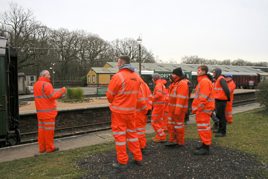“Some of the guys in there will probably never set foot on the railway.”
Those ‘guys’ are students.
Or, more correctly, they’re apprentices.
They’re a diverse group, comprising school leavers, designers, planners, on-track workers and fitters from Network Rail, freight operators, and construction and infrastructure companies.
Different ages, differing levels of experience.
But they have two things in common.
One, as part of their apprenticeships, they’re all on London South Bank University’s Rail & Rail Systems Engineering course.
Two, they’ve joined LSBU Senior Lecturer Dr Nathan Darroch for a day out at the heritage Bluebell Railway in Sussex.
This is not a jolly.
It’s designed to give those whose day jobs, although in the rail industry and having a day-to-day impact on the railway, may not appreciate the nature of its systems.
It is the opportunity to truly experience and understand the thing that they serve.
“This is an essential factor in their roles as railway engineers,” says Darroch.
“An apprentice may have many years working on the track, as a specific discipline. But do they understand the ultimate systems nature of that track and their role within the wider system?”
What LSBU’s Rail & Rail Systems Engineering course attempts to do is to break down divisions, so that apprentices might consider how factors from different disciplines might affect their own work, and vice versa.
Darroch explains: “Take overhead line equipment. There’s an interface between the train and the OLE and where the OLE is connected to the National Grid.
"However, those internal railway systems are also inter-connected and interdependent on external systems such as the OLE interfacing with the physical and natural environment.
“A bridge, for example, may need to be raised or replaced during electrification, to enable people to cross the railway safely, whenever they wish. Removing that bridge would result in potentially unacceptable adverse effects on people living within a local area and their ability to go about their normal lives.
“A failure in the reliability, availability and maintainability (RAMs) of any one of these interfaces subsequently has a cascading effect throughout the rest of the railway system.”
Finding such a location to get up close and personal with the railway is not easy.
Hence a visit to the Bluebell Railway.
Everything here has the same weight and ‘presence’ as you’d find on (say) Network Rail. But unlike the ‘Big Railway’, it has extended shutdown periods.
This enables the railway to be easily turned into an 11-mile open-air classroom.
It was during such a shutdown that 24 apprentices gathered at a very chilly East Grinstead station on January 15, in preparation for a day of learning outside of the classroom.
But before getting into the detail of the day, what is the Rail & Rail Systems course?
“As railway engineers, it is essential that no matter their role/discipline, our apprentices must understand the railway as a system,” says Darroch.
“It’s achieved by their being able to go down onto the track and see what goes on outside of their disciplinary focus. Through this approach, the designer of railway infrastructure within a project, even though they may work in an office, can make far more effective decisions to minimise risk to the safe, time, and cost-effective operation of the railway.”
The course is not only for apprentices coming straight from education into the rail industry. It’s also for those already in the industry to up-skill”.
“And the railway industry needs a heck of a lot of people to be up-skilled,” notes Darroch.
You have guys here with fantastic knowledge, but they don’t necessarily have the degree, engineering management skills, and the science and theory to back up their practical knowledge. The apprenticeship is basically: ‘You want to be an engineer. This is the knowledge and the skills that you need to have. But you need to be able to demonstrate these skills.’
“What we at the university do is work with the employer. The employer provides on-the-job training and opportunities for the students to go and do some different types of work. What we give them is the international benchmarkable engineering management skills, science, theory, maths.”
The Williams-Shapps Plan for Rail highlighted that the rail industry needed to change its methods of management, engineering, and stakeholder management. That’s what the Rail & Rail Systems Engineering course addresses.
But the course’s origins go back further than when the plan was finally published in 2021.
“In 2018, the Institute for Apprenticeships and Technical Engineering, in consultation with the National Skills Academy for Rail, the rail industry and its supply chain, developed several apprenticeship standards for Rail & Rail Systems Engineering,” says Darroch.
Now LSBU’s Senior Lecturer, Darroch spent 20 years working at Transport for London. For more than 12 of those, he was an asset systems engineer at London Underground.
He has used his experience to build a course that “directly addresses the needs of the UK and potentially international railway industries”.
He’s also recognised that engineers are “practical people”, and has therefore adopted a “style of teaching, which is more interactive”.
Apprentices undertaking the LSBU course can enjoy Level 5 FdEng and Level 6 BEng degree-level learning.
This article is part of a bigger insight feature in RAIL 1005. Get your copy delivered to your letterbox or inbox.
















Login to comment
Comments
No comments have been made yet.